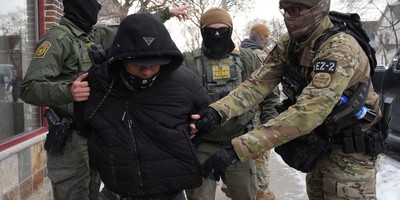You wouldn't have thought it possible. But then, you underestimate the ingenuity of the New York Times.
The house organ of the liberal church in America, the Times covered opening day of the trial of one of the worst killers in 20th century history without mentioning the "c" word even once.

What technique! The 18-paragraph story certainly made clear that the reporter, Seth Mydans, was none too pleased with the defendant. That much was clear. Kaing Guek Eav (known as Duch) had been commandant of the Tuol Sleng prison camp in Cambodia under the Khmer Rouge. Who were they? Well, according to the story, they presided over a "fanatical . . . government between 1975 and 1979." That they certainly did. But they were communist fanatics, and the Times managed to elide that detail. It's odd because in other contexts the Times is not shy about characterizing governments' political tilt. The Times put the words "right-wing" together with the Pinochet regime in Chile so often you'd have thought it was part of the title. "The Right-Wing Regime of Augusto Pinochet." It was the same with the "right-wing" government of El Salvador when the FMLN communist movement was attempting to overthrow it. The Times has even used the term "conservative" to describe the mullahs in Iran and the Taliban in Afghanistan.
"In Tuol Sleng," Mydans writes, "a prisoner was not only presumed guilty but also tortured until he offered whatever was demanded It was a prison where Duch's word was final and an order like 'kill them all' was a death sentence." Well, yes.
Recommended
Mydans tells us that hundreds of "diplomats, journalists, human rights workers, and other victims of the Khmer Rouge" attended the trial and quotes one survivor about the horrors he suffered. "When I was in jail, I could get three spoons of porridge a day and both my legs were put in shackles." The reporter also mentions that the Khmer Rouge are thought to have murdered as many 1.7 million Cambodians during their short reign.
But this spare account hardly does justice to the story. One cannot understand the catastrophe that befell Cambodia without knowing that the people who engineered this gruesome slaughter were intellectuals who dreamed of a better world. Nearly all of the Khmer Rouge leaders had studied abroad, in Paris, where they became drunk on tales of the French Revolution and learned their craft from the French Communist party. "We are making a unique revolution," boasted one official at the time. "Is there any other country that would dare abolish money and markets the way we have? We are much better than the Chinese, who look up to us. We are a good model for the whole world." Pol Pot himself said "only a few thousand Cambodians have died as a result of the application of our policy of bringing abundance to the people."
Abundance to the people. A model for the world. The Khmer Rouge modeled themselves on Mao and Lenin and then shifted into overdrive. They emptied the cities of their inhabitants and force-marched everyone -- the elderly, the sick, pregnant women, children -- in the tropical heat to the countryside where there were no facilities, little drinking water, scarce food, no medicine, and no shelter except thatched huts. There they were starved and enslaved when they weren't shot on the spot for some minor infraction. Anyone who had any connection to the West or to modernity itself was suspect. People who spoke other languages, owned a typewriter or eyeglasses, or any forbidden book could be shot. Failure to make sufficiently abject apologies for ideological errors was enough to merit a bullet between the eyes.
As the Black Book of Communism records, "Democratic Kampuchea was a place with no values or stable points of reference. It really was a nightmare world on the other side of the mirror. The first article of faith was a radical dismissal of the idea that human life had any value. 'Losing you is not a loss, and keeping you is no specific gain' went one terrifying official slogan that recurs time and again in statements by witnesses." Khmer leaders talked of a radiant future, in which agricultural production, in obedience to Pol Pot's Four-Year Plan, would double or quintuple. Instead, the starving, displaced, and thoroughly terrorized Cambodian people saw crop production cut in half in just two years. While they watched their children die in their arms they were herded off to "self-criticism" sessions where their every facial twitch was carefully monitored by gun-wielding Khmer Rouge. The Black Book also records that "Everyone ran the risk of denunciation following a chance encounter with an old friend, colleague, or student ..."

It may be that the evil done in the name of revolution exceeds all other manmade disasters. Certainly one cannot begin to confront Cambodia's grisly history without acknowledging that communists committed this atrocity.

























Join the conversation as a VIP Member